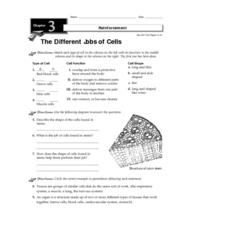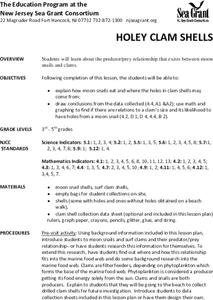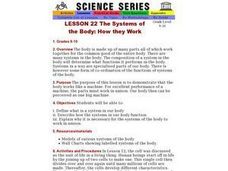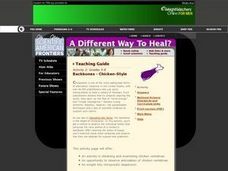Curated OER
The Different Jobs of Cells
In this cells worksheet, students review different types of cells including their different functions and shapes. This worksheet has 6 matching and 3 short answer questions.
Curated OER
Beautiful Birds: Non-Fiction Reading Comprehension Worksheet
In this birds reading comprehension worksheet, students read a short non-fiction selections about the characteristics of birds. They answer 10 questions based on the reading which include true or false, short answer, and multiple choice.
Curated OER
Tissue Types
In this human tissue worksheet, students read about the 4 different tissue types in the body. Students read 4 pages about the types.
Curated OER
Aerobic vs. Anaerobic Respiration
Learners define aerobic and anaerobic respiration. They compare and contrast the processes of aerobic and anaerobic respiration. Students identify organisms that use the processes of aerobic and anaerobic to synthesize energy from food.
Curated OER
Selling Cells: a Study of Organelles and Cell Structure
Students study cellular structures and functions. In this cell function lesson students participate in a class discussion then make a drawing of the cell they are discussing.
Curated OER
Holey Clamshells
Students analyze data to make hypotheses and conclusions regarding the predator/prey relationship between moon snail and surf clams.
Curated OER
The Systems of the Body: How they Work
Students study what a body system is, how they function and how the systems work in unison.
Curated OER
Vertebrate Skeletons
In this biology instructional activity, students examine the human skeleton and then classify animal bones according to their similar function.
Curated OER
Molecules of Life
In this molecules worksheet, learners read a 1 page article on molecules and then answer 10 true or false, multiple choice, short answer and/or fill in the blank questions referring to the article.
Curated OER
Forensics: Who Killed the Iceman?
Students explore how archaeologist examine mummies. In this research based lesson, students work in groups to research two mummies and report their findings to the class through role-playing and using a model of the mummy.
Curated OER
From One End to the Other
Seventh graders become more familiar with how our food is broken down mechanically and chemically. They also trace the food through the alimentary canal.
Curated OER
What is an Organism?
Sixth graders take a pre-test and summarize teacher's discussion of cells, tissues, organs in their notebooks. They read selections on organisms in their textbook and perform a dissection of a chicken drumstick with the thigh attached....
Curated OER
Backbones - Chicken-Style
Students observe individual bones that comprise the neck portion of a chicken's backbone. After cleaning the bones of tissue, they examine the dried vertebrae and observe how they are adapted for support and protection.
Curated OER
The Talk Show: A Bioethical Dilemma About Neurological Disorders
Students explore neurological societal problems. They research, collect information and assess the ramifications of ethical, economic, political, and social issues. During a talk show simulation, students present their decisions.
Curated OER
Boys and Puberty
Learners describe the internal and external changes boys experience during puberty. Through lecture, students are introduced to changes that faced once the reach puberty. A discussion of personal experience follows the lecture.
Curated OER
CSI Clamshell Investigation
Pupils explore and explain how moon snails eat and where the holes in clamshells come from and then draw conclusion from the data collected. They incorporate math and graphing skills to determine if there is a relationship to a clam's...
Curated OER
Matching Flowers With Their Pollinators
Middle schoolers match flowers to pollinators and construct models of
flowers to demonstrate why different kinds of flowers need different kinds of
pollinators. They use their flower models and the "Scientific Method Format" included in...
Curated OER
Cardiovascular System Definitions and Study Questions
In this cardiovascular system study question worksheet, pupils define 21 words associated with this system. They answer 16 short answer questions related to circulation of blood through the body.
Curated OER
Mammals
In this mammals worksheet, students review terms associated with the different types of mammals. This worksheet has 6 fill in the blank and 4 matching questions.
Curated OER
Make Sense of Nature
Pupils participate in this program that heightens their awareness and curiosity of nature as well as their sense of adventure and exploring new surroundings. They identify and choose an object from nature after exploring it with other...
Curated OER
Protein
Learners examine protein, what it is and how it functions in the body. In this protein lesson students study the food pyramid, what a protein is and what it does.
Curated OER
Bird Banter
Students listen to examples of common bird songs of birds found in Illinois. As a class, they discover the importance between the differences in songs and calls. They practice making their own bird calls and songs to end the lesson.
Curated OER
Cells
Third graders investigate yeast to extend their understanding of living and non-living things.
Curated OER
Molecular Approaches to Evolution
Students are introduced to working with molecular data. The first activity does both simulated and original data are used to compare amino acid, protein or DNA differences to construct phylogenetic trees or cladograms. These activities...
Other popular searches
- Major Muscle Groups
- 6 Major Muscle Groups
- Major Muscle Groups Chart
- Teaching Major Muscle Groups
- Large Muscle Groups
- Complementary Muscle Groups
- Major Muscle Groups Diagram
- Major Skeletal Muscle Groups
- 6 Muscle Groups
- Identify Muscle Groups
- Pe Muscle Groups
- Major Sleletal Muscle Groups

























